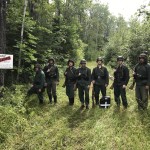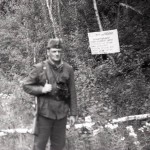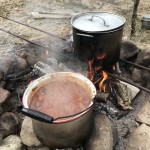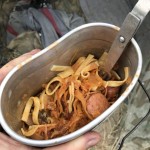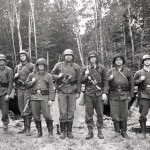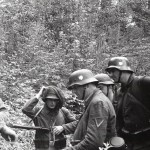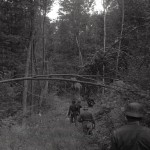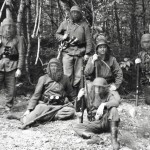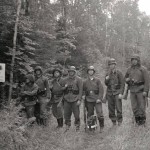To illustrate how we plan reenactment events based on historical documentation, I will use the example of an event we hosted in Bethel, Maine, in August 2020. The chosen historical scenario for the event was the struggle between 281. Sicherungs-Division and the 2nd Leningrad Partisan Brigade in northwest Russia (near the towns of Iasski and Kholm), August 1942. The scenario was chosen in part based on the easy availability of historical documentation pertaining to the events. Some of the combat actions between these two units are the focus of the Osprey book “Soviet Partisan versus German Security Soldier” which was published in 2019, and this book was recommended reading for all participants prior to the event. In addition, the war diary of the 281. Sich. Div. from this time is available free online as a scanned NARA microfilm roll (T315 R1871) and we were able to use this source for extremely detailed information. We chose a specific scenario that was a good match for the climate, terrain and setting at the site where the event would be held. We also chose to represent actions that would be well-suited for an event with a very small number of participants.
What follows is from the event primer, made available to all participants a month before the event.
“What we will be portraying, specifically, will be the forest outside the town of Woronzowo, August 22, 1942.
Background: The terrain in north-western Russia features dense forests, lakes, and marshland, and is very difficult to traverse in any season. Between July and December 1941, a “Leningrad Partisan Zone” in the area of Lake Polisto grows to a strength of over 1,000 men. These partisans inflict significant casualties in the German rear area units of Army Group North. In response to this growing threat, the Germans undertake a series of anti-partisan operations in August and September 1942. These operations have varying degrees of success, but by the end of September the Leningrad Partisan Zone has been destroyed. In the days prior to August 22 there were numerous encounters between German troops and Partisans in the area of operations of the 281. Sich. Div.:
-August 18: One action results in 2 dead partisans and the capture by the Germans of 1 light machine gun and 2 rifles. A scout troop encounters a band of 100 partisans. A factory is burned down by partisans. German units push into partisan controlled territory.
-August 19: Germans chase a Partisan group that had waged a hand grenade battle against local security forces. A Partisan headquarters with 150 men is reportedly plundering the area.
-August 20: Constant movement of small partisan groups is observed, larger partisan groups are reported. A clash between a German scout troop and 50 partisans results in 3 dead on each side. Local security does battle with partisans, with 6 partisans killed (2 of them women). One of the local security troops is killed, another defects to the partisans. A German force of over 200 men with 3 Flak guns undertakes an offensive operation against a band reported to have 120-150 partisans.
-August 21: Hundreds of partisans surround local security forces. The German offensive of the previous day was not successful. Despite being surrounded, the Partisans slipped away.
-August 22: a fight between German Polizei troops and partisans results in 8 dead partisans, 8 wounded Germans. Partisans attack and partially burn down an industrial building. Small partisan groups are reported.
Soviet overview: In 1941, the 2nd Leningrad Partisan Brigade was very irregularly equipped, but that was changing in 1942. By this stage of the war they were being supervised by an increasing number of officers and other uniformed personnel sent from Soviet lines. Entire detachments were sent by the Red Army, tasked with committing acts of sabotage and diversion. By August 1942 the Partisans were made up of Red Army troops who escaped POW camps or encirclement, mobilized young people from the area, and Red Army detachments. Weapons and equipment were being flown in, airdropped, or brought from Soviet lines. The numbers of light and heavy machine guns as well as mortars were increasing at this time. Soviet participants at this event will be portraying a small Partisan force recently separated from a larger band, having been pushed into a new area by German offensives. You know much larger German forces are active somewhere in the vicinity.
German overview: Sicherungs-Bataillon 869 has just arrived in the town of Woronzowo. Partisan activity in this sector is constant. Our Bataillon is stretched thin, our tiny force has been ordered to establish an outpost outside the town. The size and strength of Partisan bands in this forest is unknown. But we know they are there.
IMPORTANT FOR BOTH SIDES: This forest is vast and unfamiliar. The only thing you know about it for sure is that it is extremely dangerous. Your movements will be dictated by your command. You must obey all orders exactly. If you get separated or lost- you are as good as dead. Expect to remain close to roads and trails. Neither side has the capability for offensive actions of any scale, nor the ability to conduct a sustained defense.”
In addition to this event primer, specific uniform guidelines for German participants were also published well before the event, as well as logistical information about accommodations, food and water:
“-Uniform: We will be wearing the Drillichanzug (HBT uniform). Jackets should be the 2 pocket green M40 style without breast eagle/collar tabs/shoulder straps (rank insignia only). Trousers could be M40 or M42 pattern.
-Equipment: We are going for a fairly uniform look. The belt should be set up with bread bag, canteen, mess kit, bayonet, gas mask canister, and 2 K98 style ammunition pouches. Bayonet can be German or Czech (German preferred). Entrenching tool in carrier is optional. Y-straps should not be worn. Use of a bread bag strap to support the weight of the suspenders (if desired) is preferred.
-Headgear: M34 field cap without soutache, single decal M35 or M40 helmet. Mosquito nets are encouraged.
-Weapon: K98 or Czech VZ24 (K98 preferred)
-Footwear: if you have jackboots, wear them. Low boots only permitted if that’s all you have.
Tentage: We will be erecting a communal tent in which everyone can sleep. Bedding is on you. One or two blankets and/or an overcoat should suffice. No pillows or mattresses of any kind. If you desire, you can bring your own Zeltbahn tent and sleep in it. This is an authenticity compromise but will create the appearance of a larger outpost that will be occupied by more troops “coming later.”
Water: Bring one gallon of water and keep it in your car as a reserve in case we need this.
Food: There will be one communal meal on Saturday. All other meals are on you. Ideas for stuff to bring include unsliced bread, cheese or salami wrapped in wax paper, food in unlabeled cans/jars. You can fit quite a bit of food in your mess kit.
Forbidden: Anything modern, M43 anything. This is a 1942 scenario. Tropical equipment is not authorized. Taking of digital photos should be kept to a minimum. Be discrete or take photos at times when we are not in time travel mode.
Historical note on the use of Czech weapons: This soldier was in the unit we will be portraying, he was initially trained on Czech weapons and later on the K98. https://festung.net/wehrpass-of-a-gefreiter-in…/“
The guidelines were illustrated with this wartime image representative of the desired look for this event.
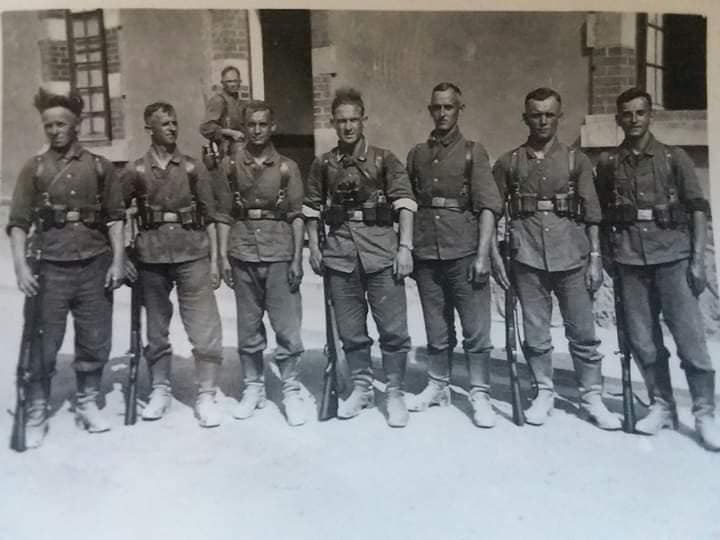
Uniform and equipment standards for partisans at the event were left to the discretion of the Soviet Partisan reenactment group that hosted and helped to organize the event, the 3rd Partisan Brigade.
Signage related to partisans, the unit we were portraying, and the area of the scenario, was created in advance and installed at the site, as a form of visual prop to help set the stage.
The tent erected at the site consisted of Zeltbahn shelter quarters. The communal meal prepared for the event was Szegediner Gulasch, based on this Wehrmacht recipe, and was prepared on site with period style equipment.
The event was a success. Total participation was 10 people, with 8 portraying German Army soldiers and 2 portraying Soviet partisans. These images from the event were taken with cameras from that era.
